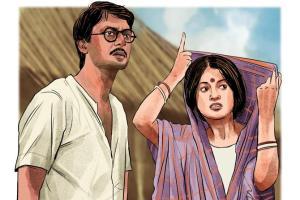Yet, it seems a prescient film for 2020, in which poverty and hunger are even more widespread in the midst of plenty, yet largely invisible to the government and the middle class

Illustration/Uday Mohite
![]() Last week I watched Satyajit Ray's Ashani Sanket (Distant Thunder), by way of nursing a broken heart. I was in mourning after the passing away on November 15 of Soumitra Chatterjee, the internationally acclaimed Bengali actor, on whom I had a massive crush. He played the lead in the film, along with stunning Bangladeshi actress Babita. Ray, who made the film in 1973, shows us the impact of the manmade Bengal famine of 1943, in which an estimated five million died. Yet, it seems a prescient film for 2020, in which poverty and hunger are even more widespread in the midst of plenty, yet largely invisible to the government and the middle class.
Last week I watched Satyajit Ray's Ashani Sanket (Distant Thunder), by way of nursing a broken heart. I was in mourning after the passing away on November 15 of Soumitra Chatterjee, the internationally acclaimed Bengali actor, on whom I had a massive crush. He played the lead in the film, along with stunning Bangladeshi actress Babita. Ray, who made the film in 1973, shows us the impact of the manmade Bengal famine of 1943, in which an estimated five million died. Yet, it seems a prescient film for 2020, in which poverty and hunger are even more widespread in the midst of plenty, yet largely invisible to the government and the middle class.
Over 120 million of India's rural poor, seasonal migrants looking for work, are estimated to have walked home across entire states by foot, driven by hunger, following the ill-prepared national lockdown declared in March this year because of COVID-19. On Ashani Sanket, more anon. Mrinal Sen's Akaler Sandhane (In Search of Famine, 1971) also made us acutely aware of the hunger in rural areas; pervasive, yet invisible to middle class eyes.
ADVERTISEMENT
Chatterjee's work spanned about 300 films and series in a 62-year career, including 14 films directed by Satyajit Ray, starting with Apur Sansar (1959). He had acted with most top Bengali directors, including Ray, Mrinal Sen, Aparna Sen, Rituparno Ghosh, Tapan Sinha and Goutam Ghose. His many laurels include the Padma Bhushan, National Film Award and Dadasaheb Phalke Award in India, as well as the French Legion of Honour.
Chatterjee was protagonist in Ray's films that were shown at Berlin, Cannes, and many festivals worldwide. He had four films at the Berlin Film Festival alone, including three by Satyajit Ray. He was in Ray's Ashani Sanket, which won the Golden Bear in Berlin in 1973. Earlier, he was in Ray's Charulata (The Lonely Wife, 1964) for which Ray won the Silver Bear for Best Director in 1965. He was also in Ray's Ghare Baire (The Home and the World, 1988), and in German director's Florian Gallenberger's Shadows of Time, 2005. Moreover, no Bollywood star could match his staggering range of talents—he was also a prolific theatre actor, writer and director; poet, painter, author and co-founder and former editor of the literary magazine, Ekkhon. He was a committed Leftist and his last published piece was for the Puja volume of Ganashakti, the newspaper of the Communist Party of India (Marxist). When journalist Guillaume Delacroix interviewed me last week on Chatterjee for Le Monde, the highly respected French newspaper, I asked him if he could think of any contemporary French actor who could match all of Chatterjee's talents, and he said no. That was very telling.
In Ashani Sanket (freely available online), Gangacharan Chakravarti (Chatterjee) and his stunning wife Ananga (Babita) are the only Brahmin family in a tiny Bengali village. It is 1943, during World War II, and war planes are flying overhead, but the village is so remote, the villagers are excited by how beautiful the planes look. Soon, the famine hits home—although the harvest was plentiful, the British had diverted local rice supplies for its armies, causing horrific deaths by hunger. Gangacharan, who triples up as a priest, doctor and teacher, and receives plentiful food in return, quickly realises his bhadralok-ness won't fill his belly, as desperate villagers loot the grocer, and women sell their bodies in exchange for a fistful of rice. In the climax, we see hundreds of starving people leaving the villages for cities, in search of food.
By making us deeply emotionally invested in the story of a single couple, Gangacharan and Ananga (and her friend Chutki, played by the remarkable Sandhya Roy), Ray makes every number in the five million count. Throughout the film, we see joyous nature—a plentiful harvest, red butterflies and dragonflies gambolling, even as human lives are devastated—a fact highlighted in Bibhutibhushan Bandopadhyay's novel, on which the film is based. Nature carries on, indifferent to human suffering. The film also underlines how swiftly a crisis can reduce men to beasts.
Meenakshi Shedde is India and South Asia Delegate to the Berlin International Film Festival, National Award-winning critic, curator to festivals worldwide and journalist. Reach her at meenakshi.shedde@mid-day.com
Keep scrolling to read more news
Catch up on all the latest Mumbai news, crime news, current affairs, and a complete guide from food to things to do and events across Mumbai. Also download the new mid-day Android and iOS apps to get latest updates.
Mid-Day is now on Telegram. Click here to join our channel (@middayinfomedialtd) and stay updated with the latest news
 Subscribe today by clicking the link and stay updated with the latest news!" Click here!
Subscribe today by clicking the link and stay updated with the latest news!" Click here!







